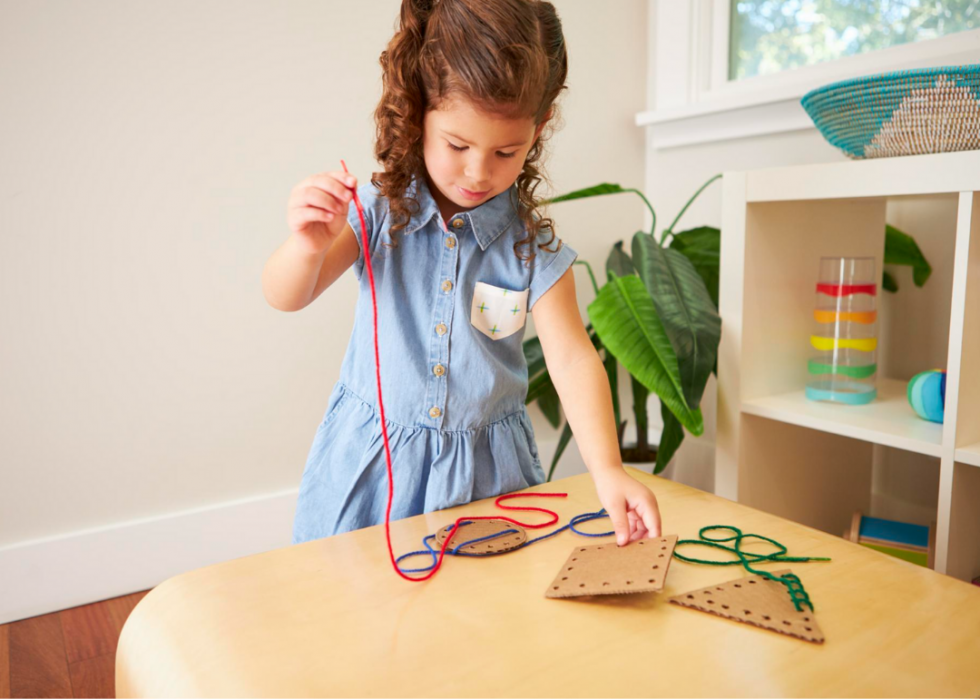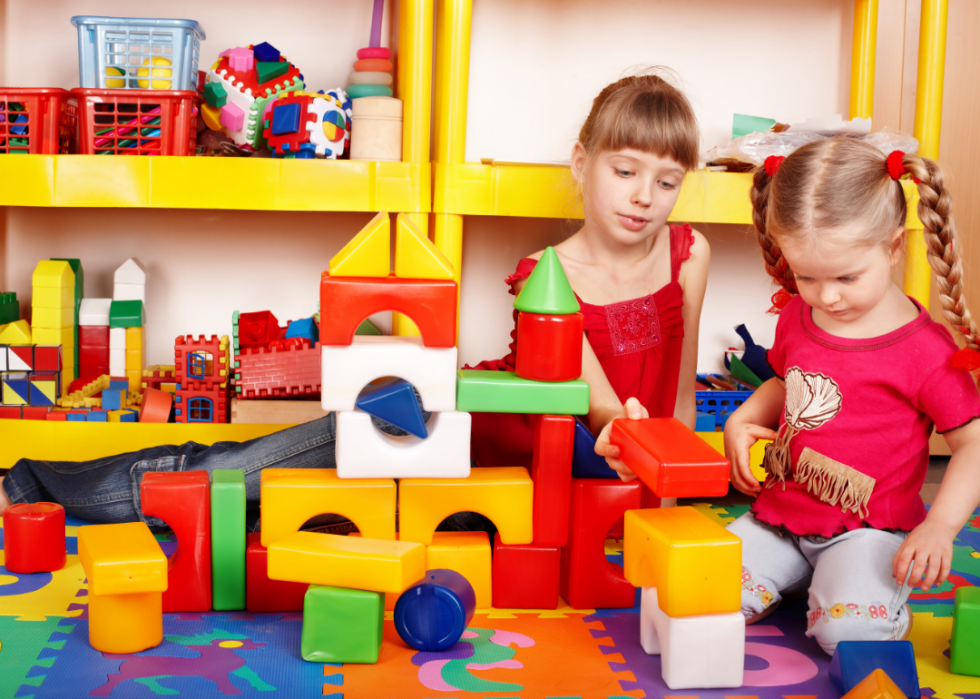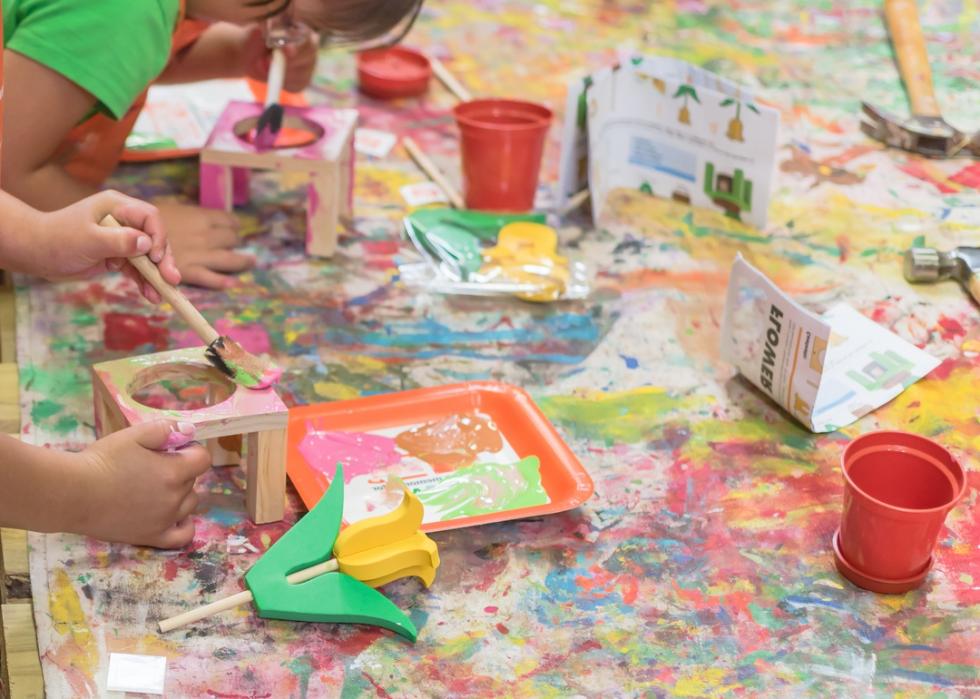
This story originally appeared on Stacker and was produced and distributed in partnership with Stacker Studio.
Preschool programs and statistics in every state
Preschool is often the first time children are exposed to not only the academics of school, but also the social and emotional aspects of making friends, learning how to share, and figuring out how to get along in a group. Preschool is also the first time many children are exposed to a routine, and it can lay the foundation for a child’s future in school. Many preschool-age children are considered at-risk, and they are impacted the most when preschool is not an option, which is why state and federal preschool programs are so vital.
Lovevery used data from the National Institute for Early Education Research’s report on The State of Preschool 2019, released in 2020, to compile statistics on preschool programs in every state and Washington, D.C. Statistics include information on both federal- and state-funded preschool programs for 2018–2019, the most recent available year, when 1,629,804 children attended preschool.
There were 62 state-funded preschool programs across 44 states and Washington, D.C., and state spending on preschool totaled $8,750,666,956. Idaho, Indiana, New Hampshire, South Dakota, Utah, and Wyoming did not offer state preschool programs, but federally funded programs were still available for children in these states. Please note that the coronavirus could have temporarily affected preschool programs and policies in each state.
Join Lovevery as it explores preschool programs in the United States.

Alabama
- State preschool program available: Yes
- Children enrolled in state preschool: 3-year-olds: 0 (0%); 4-year-olds: 18,756 (32%)
- Children enrolled in special education preschool: 3-year-olds: 1,518 (3%); 4-year-olds: 2,534 (4%)
- Children enrolled in federally funded Head Start: 3-year-olds: 5,555; 4-year-olds: 6,048
- Total state preschool spending: $95,962,050
--- State spending per child: $5,116 (#21 among states)
- Federal Head Start funding: $107,563,968
Alabama’s First Class Pre-K program is a state-funded voluntary program for 4-year-old children who reside in the state. Funded by the Education Trust Fund and the Preschool Development Grant through the Alabama Department of Early Childhood Education Office of School Readiness, the National Institute for Early Education Research (NIEER) awarded the program its highest quality rating for 13 years in a row, and the state meets 10 out of 10 quality standard benchmarks. Children must be 4 on or before Sept. 1 of the registration year, and each program holds a random selection drawing with children either being put in pending status if accepted or waitlisted.

Alaska
- State preschool program available: Yes
- Children enrolled in state preschool: 3-year-olds: 261 (2%); 4-year-olds: 1,043 (10%)
- Children enrolled in special education preschool: 3-year-olds: 559 (5%); 4-year-olds: 876 (8%)
- Children enrolled in federally funded Head Start: 3-year-olds: 471; 4-year-olds: 565
- Total state preschool spending: $7,200,000
--- State spending per child: $5,521 (#19 among states)
- Federal Head Start funding: $38,517,039
The state’s Department of Education and Early Development provides funding to 15 Head Start programs throughout Alaska. These programs serve Alaska’s children between 3 and 5 in a classroom setting. The Teaching Strategies assessment was piloted during the 2011–2012 school year; this tool continues to be used several times throughout the year and is required by state policy for all pre-elementary grantee programs.

Arizona
- State preschool program available: Yes
- Children enrolled in state preschool: 3-year-olds: 1,986 (2%); 4-year-olds: 3,424 (4%)
- Children enrolled in special education preschool: 3-year-olds: 3,737 (4%); 4-year-olds: 5,993 (7%)
- Children enrolled in federally funded Head Start: 3-year-olds: 4,150; 4-year-olds: 6,246
- Total state preschool spending: $21,712,929
--- State spending per child: $4,013 (#29 among states)
- Federal Head Start funding: $159,680,887
Quality First provides a limited number of scholarships funded by First Things First, which helps low-income families afford early child care and education for their children aged birth through 5, and these are provided on a first-come, first-served basis for eligible families. Head Start also provides early child care education for children 3 through 5 for those families at or below the federal poverty level. The state and federally mandated program, Early Childhood Special Education, is for children ages 3 through 5, though they must meet state eligibility criteria and be experiencing developmental delays.

Arkansas
- State preschool program available: Yes
- Children enrolled in state preschool: 3-year-olds: 7,071 (18%); 4-year-olds: 12,256 (32%)
- Children enrolled in special education preschool: 3-year-olds: 2,941 (8%); 4-year-olds: 5,444 (14%)
- Children enrolled in federally funded Head Start: 3-year-olds: 3,544; 4-year-olds: 2,769
- Total state preschool spending: $113,276,553
--- State spending per child: $5,612 (#18 among states)
- Federal Head Start funding: $54,679,908
The state of Arkansas met an impressive eight out of 10 quality standard benchmarks in the National Institute for Early Education Research (NIEER) The State of Preschool 2019 report. These include teacher specialized training, maximum class size of 20 or fewer 3- and 4-year-olds, and a staff/child ratio of 1-to-10 or better, also for 3- and 4-year-olds. Both The Arkansas Better Chance program, which serves children from birth through 5 who meet certain family income requirements, and the Arkansas Better Chance for School Success, which supports 3- and 4-year-olds in households with incomes up to 200% of the federal poverty level, further early childhood education in the state.

California
- State preschool program available: Yes
- Children enrolled in state preschool: 3-year-olds: 57,447 (12%); 4-year-olds: 187,565 (38%)
- Children enrolled in special education preschool: 3-year-olds: 22,208 (4%); 4-year-olds: 30,099 (6%)
- Children enrolled in federally funded Head Start: 3-year-olds: 33,169; 4-year-olds: 32,194
- Total state preschool spending: $2,027,027,473
--- State spending per child: $8,253 (#7 among states)
- Federal Head Start funding: $946,841,833
California’s two state preschool programs are the California State Preschool Program (CSPP) and the Transitional Kindergarten (TK) Program. The CSPP age cutoff for 3- and 4-year-olds is Dec. 1, and it provides both full- and part-day preschool based on certain requirements including family income. The TK Program is for children born between Sept. 2 and Dec. 2 and is the first year of a two-year kindergarten program.

Colorado
- State preschool program available: Yes
- Children enrolled in state preschool: 3-year-olds: 5,877 (9%); 4-year-olds: 15,616 (23%)
- Children enrolled in special education preschool: 3-year-olds: 3,604 (5%); 4-year-olds: 5,020 (7%)
- Children enrolled in federally funded Head Start: 3-year-olds: 3,370; 4-year-olds: 4,289
- Total state preschool spending: $61,161,584
--- State spending per child: $2,787 (#39 among states)
- Federal Head Start funding: $89,238,668
Under the Colorado Department of Education, the Colorado Preschool Program (CPP) is a state-funded early childhood education program that allows more than 29,000 children, in 176 out of 179 school districts in the state and who are deemed at-risk for later school failure, to attend preschool either half- or full-time. Managed by local school districts and advisory councils, each school district that participates in the CPP receives a predetermined number of positions for eligible children. They attend preschool in one of the following settings: school district settings, local child care centers, community preschools, or Head Start programs.

Connecticut
- State preschool program available: Yes
- Children enrolled in state preschool: 3-year-olds: 3,330 (9%); 4-year-olds: 11,528 (31%)
- Children enrolled in special education preschool: 3-year-olds: 2,711 (7%); 4-year-olds: 3,335 (9%)
- Children enrolled in federally funded Head Start: 3-year-olds: 1,928; 4-year-olds: 2,278
- Total state preschool spending: $131,864,893
--- State spending per child: $8,786 (#5 among states)
- Federal Head Start funding: $47,054,372
The Connecticut Office of Early Childhood (OEC) oversees three state-funded programs—School Readiness Program, Child Day Care Contracts, and Smart Start—which serve 3- and 4-year-olds in the state. A federally funded Preschool Development Birth through Five Renewal Grant was awarded to the OEC for $27 million in 2019.

Delaware
- State preschool program available: Yes
- Children enrolled in state preschool: 3-year-olds: 264 (2%); 4-year-olds: 581 (5%)
- Children enrolled in special education preschool: 3-year-olds: 694 (6%); 4-year-olds: 968 (9%)
- Children enrolled in federally funded Head Start: 3-year-olds: 635; 4-year-olds: 849
- Total state preschool spending: $6,149,300
--- State spending per child: $7,277 (#9 among states)
- Federal Head Start funding: $13,199,992
The Delaware Early Childhood Assistance Program (ECAP), which began in 1994 and originally only provided early childhood learning to 4-year-olds, expanded its eligibility to 3-year-olds with the 2017–2018 school year. The state’s ECAP is modeled after federal Head Start and is mainly comprised of families at or below 100% of the federal poverty level. Children with disabilities are allowed entrance into the program with 10% of enrollment slots specifically set aside for them.

Florida
- State preschool program available: Yes
- Children enrolled in state preschool: 3-year-olds: 0 (0%); 4-year-olds: 173,633 (75%)
- Children enrolled in special education preschool: 3-year-olds: 8,846 (4%); 4-year-olds: 14,255 (6%)
- Children enrolled in federally funded Head Start: 3-year-olds: 13,847; 4-year-olds: 17,212
- Total state preschool spending: $391,215,901
--- State spending per child: $2,253 (#42 among states)
- Federal Head Start funding: $304,713,474
Launched in 2005, Florida’s Voluntary Prekindergarten Education Program provides prekindergarten for all 4-year-olds, though in 2016–2017 parents were allowed to put the program off for a year, which opened up eligibility to 5-year-olds. Children who meet the age requirements are enrolled in one of two programs—a summer program that is 300 hours or a full school year program that is 540 instructional hours. School-year program teachers must have a child development associate’s degree or equivalent credential, while summer program teachers must have a bachelor’s degree.

Georgia
- State preschool program available: Yes
- Children enrolled in state preschool: 3-year-olds: 0 (0%); 4-year-olds: 80,493 (60%)
- Children enrolled in special education preschool: 3-year-olds: 3,640 (3%); 4-year-olds: 6,030 (5%)
- Children enrolled in federally funded Head Start: 3-year-olds: 11,312; 4-year-olds: 8,275
- Total state preschool spending: $365,326,541
--- State spending per child: $4,539 (#26 among states)
- Federal Head Start funding: $179,353,244
Updated in 2018–2019, the state’s Early Learning and Development Standards were only one of the bright spots for education. Teachers, including lead pre-K teachers in both public and private settings, received a $3,000 salary increase as part of the state’s 2020 budget. Launched as a pilot program in 1992, Georgia’s pre-K program’s 1995 expansion made it the first state-funded universal preschool program in the nation for 4-year-olds.

Hawaii
- State preschool program available: Yes
- Children enrolled in state preschool: 3-year-olds: 0 (0%); 4-year-olds: 415 (2%)
- Children enrolled in special education preschool: 3-year-olds: 744 (4%); 4-year-olds: 849 (5%)
- Children enrolled in federally funded Head Start: 3-year-olds: 993; 4-year-olds: 1,291
- Total state preschool spending: $2,991,420
--- State spending per child: $7,208 (#10 among states)
- Federal Head Start funding: $21,288,971
The Hawaii Executive Office on Early Learning’s Public Prekindergarten Program (PPP) operates on the same schedule as the public elementary schools and provides services for 1,080 hours a year. The PPP teachers are required to meet certain licensure requirements including a bachelor’s degree with licensure for lead teachers and an associate’s degree for assistant teachers. The program has classroom observations that take place twice a year, and formative child assessments are also conducted throughout the year using Teaching Strategies’ Gold assessment.

Idaho
- State preschool program available: No
- Children enrolled in special education Pre-K: 3-year-olds: 905 (4%); 4-year-olds: 1,343 (6%)
- Children enrolled in federally funded Head Start: 3-year-olds: 780; 4-year-olds: 1,514
- Total state preschool spending: $0
- Federal Head Start funding: $42,177,936
While Idaho does not offer a state-funded preschool program, Temporary Assistance for Needy Families is available for early childhood education. Early childhood advocates continue to push for the state to invest in quality preschool program options, and polls have indicated that many of the state’s residents support the need for these programs as well. In 2019, the state was awarded a $3.3 million federal Preschool Development Grant Birth–Five award.

Illinois
- State preschool program available: Yes
- Children enrolled in state preschool: 3-year-olds: 33,598 (22%); 4-year-olds: 47,360 (31%)
- Children enrolled in special education preschool: 3-year-olds: 9,381 (6%); 4-year-olds: 13,245 (9%)
- Children enrolled in federally funded Head Start: 3-year-olds: 12,084; 4-year-olds: 13,830
- Total state preschool spending: $385,174,818
--- State spending per child: $4,746 (#24 among states)
- Federal Head Start funding: $268,031,152
In 2006, The Illinois Preschool for All initiative began and aspired to provide pre-K to every 3- and 4-year-old in the state by 2012. While the program is now in all counties, enrollment priority remains for all at-risk children. Thanks to the Illinois General Assembly that appropriated $50 million additional dollars to the Early Childhood Block Grant for the 2018–2019 school year, 6,000 more children were able to enroll in preschools in the state.

Indiana
- State preschool program available: No
- Children enrolled in special education Pre-K: 3-year-olds: 4,709 (5%); 4-year-olds: 6,276 (7%)
- Children enrolled in federally funded Head Start: 3-year-olds: 5,179; 4-year-olds: 6,314
- Total state preschool spending: $0
- Federal Head Start funding: $112,353,813
Though Indiana does not offer a traditional state-funded preschool program, it does offer the On My Way Pre-K program, which provides grants to eligible 4-year-olds from low-income families for qualified early education services. When the On My Way program partnered with the Early Education Matching Grant, additional counties and sites were added. Both programs include several requirements for services, including that they are delivered via public schools and by registered or licensed child care providers who have achieved either a level three or four in Paths to Quality.

Iowa
- State preschool program available: Yes
- Children enrolled in state preschool: 3-year-olds: 1,244 (3%); 4-year-olds: 26,528 (66%)
- Children enrolled in special education preschool: 3-year-olds: 1,646 (4%); 4-year-olds: 2,402 (6%)
- Children enrolled in federally funded Head Start: 3-year-olds: 2,577; 4-year-olds: 2,994
- Total state preschool spending: $89,752,273
--- State spending per child: $3,375 (#36 among states)
- Federal Head Start funding: $52,110,895
Shared Visions is one of two state-funded preschool programs in Iowa, and it has been providing preschool services to children between the ages of 3 and 5 with part-, school-, or extended-day programs since 1989 in a variety of settings including public schools, licensed nonprofit child care centers, other public nonprofit agencies, and Head Start. While the second of the state-funded programs, the Statewide Voluntary Preschool Program (SWVPP) began with the hope of providing more 4-year-olds access to preschool, and currently allows all 4-year-olds in Iowa to attend. SWVPP is based on a school funding formula and operates for at least 10 hours per week.

Kansas
- State preschool program available: Yes
- Children enrolled in state preschool: 3-year-olds: 913 (2%); 4-year-olds: 10,147 (26%)
- Children enrolled in special education preschool: 3-year-olds: 3,144 (8%); 4-year-olds: 4,207 (11%)
- Children enrolled in federally funded Head Start: 3-year-olds: 2,138; 4-year-olds: 2,939
- Total state preschool spending: $23,930,010
--- State spending per child: $2,164 (#43 among states)
- Federal Head Start funding: $58,716,305
The Kansas Preschool Pilot allows school districts in the state the financial funding to provide children from the ages of 3 to 5 with preschool services. Under the Kansas Department of Education (KSDE), during the 2018–2019 school year, the Kansas Preschool Pilot was found in 70 out of 286 school districts in the state. The other state-funded preschool program, The Kansas Preschool-Aged At-Risk Program, also operates under the KSDE and was provided in 215 out of 286 school districts in the 2018–2019 school year.

Kentucky
- State preschool program available: Yes
- Children enrolled in state preschool: 3-year-olds: 4,854 (9%); 4-year-olds: 16,497 (29%)
- Children enrolled in special education preschool: 3-year-olds: 3,832 (7%); 4-year-olds: 6,362 (11%)
- Children enrolled in federally funded Head Start: 3-year-olds: 5,607; 4-year-olds: 6,556
- Total state preschool spending: $105,163,876
--- State spending per child: $4,925 (#22 among states)
- Federal Head Start funding: $125,661,348
During the 2017–2018 year, all 173 of Kentucky’s school districts offered the Kentucky Preschool Program (KPP), which was launched in 1990. It is available to 3- and 4-year-olds with disabilities, 4-year-olds from low-income homes, and other 4-year-olds by decision of the proper school district. KPP operates for at least 2.5 hours per day for four to five days per week at either half or full days.

Louisiana
- State preschool program available: Yes
- Children enrolled in state preschool: 3-year-olds: 0 (0%); 4-year-olds: 18,841 (30%)
- Children enrolled in special education preschool: 3-year-olds: 1,768 (3%); 4-year-olds: 3,440 (6%)
- Children enrolled in federally funded Head Start: 3-year-olds: 10,642; 4-year-olds: 7,065
- Total state preschool spending: $88,579,785
--- State spending per child: $4,701 (#25 among states)
- Federal Head Start funding: $147,496,182
Louisiana has a robust early childhood education setup with three distinct state-funded preschool programs: the 8(g) Student Enhancement Block Grant Program, the Cecil J. Picard LA 4 Early Childhood Program, and the Nonpublic Schools Early Childhood Development Program. Early childhood education is also provided through the Preschool Expansion Grant, which is federally funded. Federal Title I funding is also used in public schools to provide high-quality early childhood education to pre-K kids throughout the state.

Maine
- State preschool program available: Yes
- Children enrolled in state preschool: 3-year-olds: 0 (0%); 4-year-olds: 5,805 (44%)
- Children enrolled in special education preschool: 3-year-olds: 750 (6%); 4-year-olds: 1,264 (10%)
- Children enrolled in federally funded Head Start: 3-year-olds: 949; 4-year-olds: 1,267
- Total state preschool spending: $22,220,882
--- State spending per child: $3,634 (#33 among states)
- Federal Head Start funding: $28,536,875
The state-funded program in Maine, the Public Preschool Program (PPP) for 4-year-olds, follows the state’s school funding formula and distributes funds to 150 out of the 196 school administrative units operating kindergartens. These preschool classrooms are either stand-alone programs housed within public schools or partnered with child care programs based in the community or through Head Start. The PPP meets a 1-8 staff-child ratio, includes structured classroom observations, and has a maximum classroom size of 16 students.

Maryland
- State preschool program available: Yes
- Children enrolled in state preschool: 3-year-olds: 4,000 (5%); 4-year-olds: 27,780 (38%)
- Children enrolled in special education preschool: 3-year-olds: 3,996 (5%); 4-year-olds: 5,064 (7%)
- Children enrolled in federally funded Head Start: 3-year-olds: 4,124; 4-year-olds: 3,504
- Total state preschool spending: $134,159,629
--- State spending per child: $4,184 (#28 among states)
- Federal Head Start funding: $79,250,715
The Maryland Prekindergarten Program is offered in 100% of the state’s school districts and operates for a minimum of 2.5 hours a day, five days per week. The income requirement for families of 3- and 4-years-olds is 185% of the federal poverty level, and the program meets seven out of the 10 total quality standard benchmarks established by NIEER.

Massachusetts
- State preschool program available: Yes
- Children enrolled in state preschool: 3-year-olds: 11,791 (16%); 4-year-olds: 21,642 (30%)
- Children enrolled in special education preschool: 3-year-olds: 4,381 (6%); 4-year-olds: 6,499 (9%)
- Children enrolled in federally funded Head Start: 3-year-olds: 5,056; 4-year-olds: 4,456
- Total state preschool spending: $101,170,969
--- State spending per child: $2,716 (#40 among states)
- Federal Head Start funding: $116,497,665
The Department of Early Education and Care was established in Massachusetts in 2005 and launched the Universal Pre-Kindergarten (UPK) initiative. Children 2 years and 9 months to the kindergarten eligibility age are allowed in UPK, and eligibility is not based on income level. UPK grants can be offered to public schools, private child care centers, Head Start programs, family child care, and faith-based centers if they offer full-day and full-year preschool programs.

Michigan
- State preschool program available: Yes
- Children enrolled in state preschool: 3-year-olds: 0 (0%); 4-year-olds: 37,140 (32%)
- Children enrolled in special education preschool: 3-year-olds: 5,500 (5%); 4-year-olds: 6,878 (6%)
- Children enrolled in federally funded Head Start: 3-year-olds: 11,431; 4-year-olds: 10,924
- Total state preschool spending: $244,600,000
--- State spending per child: $6,586 (#14 among states)
- Federal Head Start funding: $257,337,503
Michigan’s state-funded preschool program, for at-risk 4-year-olds, is the Great Start Readiness Program (GSRP). Administered by the Michigan Department of Education’s Office of Great Start, school districts receive funding to administer the GSRP. Under Michigan’s Great Start to Quality tiered rating and improvement system, all programs must attain a three-star or higher rating.

Minnesota
- State preschool program available: Yes
- Children enrolled in state preschool: 3-year-olds: 624 (1%); 4-year-olds: 7,613 (10%)
- Children enrolled in special education preschool: 3-year-olds: 3,951 (5%); 4-year-olds: 6,325 (9%)
- Children enrolled in federally funded Head Start: 3-year-olds: 4,242; 4-year-olds: 3,925
- Total state preschool spending: $54,114,602
--- State spending per child: $6,570 (#15 among states)
- Federal Head Start funding: $106,093,056
Head Start and Early Head Start programs are financially supplemented by the state of Minnesota. Additionally, Voluntary Prekindergarten and a variation of it, the School Readiness Plus program, provided upward of 7,000 seats allocated across 124 school districts over 193 public sites and 21 charter sites. The application and ranking process for enrollment is based on both free and reduced-price lunch percentages in the elementary schools in the state.

Mississippi
- State preschool program available: Yes
- Children enrolled in state preschool: 3-year-olds: 0 (0%); 4-year-olds: 1,954 (5%)
- Children enrolled in special education preschool: 3-year-olds: 1,380 (4%); 4-year-olds: 2,768 (7%)
- Children enrolled in federally funded Head Start: 3-year-olds: 9,398; 4-year-olds: 10,055
- Total state preschool spending: $4,490,818
--- State spending per child: $2,298 (#41 among states)
- Federal Head Start funding: $164,518,491
Mississippi’s first state-funded, voluntary pre-K program, the Early Learning Collaborative, has no income requirement and operates for a minimum of four hours a day, five days a week throughout the academic school year. The state-funded preschool program meets 10 out of the 10 quality standard benchmarks NIEER uses to evaluate school policy.

Missouri
- State preschool program available: Yes
- Children enrolled in state preschool: 3-year-olds: 1,097 (1%); 4-year-olds: 4,626 (6%)
- Children enrolled in special education preschool: 3-year-olds: 3,890 (5%); 4-year-olds: 6,708 (9%)
- Children enrolled in federally funded Head Start: 3-year-olds: 5,863; 4-year-olds: 5,033
- Total state preschool spending: $19,274,567
--- State spending per child: $3,330 (#37 among states)
- Federal Head Start funding: $122,787,425
Though the Missouri Preschool Program, which serves 3- and 4-year-olds, was launched in 1998, funding was reduced in the 2019 fiscal year and saw a reduction in the operating schedule for programs. Missouri’s Local Education Agencies were being encouraged to use the Missouri Pre-K Foundation Formula fund starting with the 2018–2019 school year.

Montana
- State preschool program available: Yes
- Children enrolled in state preschool: 3-year-olds: 2 (0%); 4-year-olds: 269 (2%)
- Children enrolled in special education preschool: 3-year-olds: 340 (3%); 4-year-olds: 554 (4%)
- Children enrolled in federally funded Head Start: 3-year-olds: 1,070; 4-year-olds: 1,344
- Total state preschool spending: $2,887,242
--- State spending per child: $8,492 (#6 among states)
- Federal Head Start funding: $38,740,356
The Montana Stars Preschool Pilot Program was authorized in 2017, but due to lack of legislative support the state-funded preschool program disappeared after the 2018–2019 school year. The state continues to support preschool programs with federal grants including the Preschool Development Grant.

Nebraska
- State preschool program available: Yes
- Children enrolled in state preschool: 3-year-olds: 4,021 (15%); 4-year-olds: 9,057 (34%)
- Children enrolled in special education preschool: 3-year-olds: 1,459 (5%); 4-year-olds: 2,316 (9%)
- Children enrolled in federally funded Head Start: 3-year-olds: 1,475; 4-year-olds: 1,788
- Total state preschool spending: $25,506,522
--- State spending per child: $1,828 (#44 among states)
- Federal Head Start funding: $35,213,474
The Nebraska Early Childhood Education Program is a state-funded program, and 70% of children who are enrolled must meet certain needs-based requirements. Under the program, most preschools operate for 3.5 to 4 hours, four to five days a week for a required minimum of 12 hours per week during the school year. Teacher requirements include a bachelor’s degree and early childhood education training.

Nevada
- State preschool program available: Yes
- Children enrolled in state preschool: 3-year-olds: 0 (0%); 4-year-olds: 2,139 (6%)
- Children enrolled in special education preschool: 3-year-olds: 1,869 (5%); 4-year-olds: 2,853 (8%)
- Children enrolled in federally funded Head Start: 3-year-olds: 1,097; 4-year-olds: 987
- Total state preschool spending: $7,848,995
--- State spending per child: $3,669 (#32 among states)
- Federal Head Start funding: $26,900,372
Both the Nevada Ready! State Pre-K and the Preschool Development Grant are administered by The Office of Early Learning and Development within the Nevada Department of Education. Those who seek funding must submit grant applications, and awards are based on community need. Enrollment preference is given to those 4- and 5-year-olds who will not be eligible to enroll in kindergarten the following year.

New Hampshire
- State preschool program available: No
- Children enrolled in special education Pre-K: 3-year-olds: 1,023 (8%); 4-year-olds: 1,251 (10%)
- Children enrolled in federally funded Head Start: 3-year-olds: 572; 4-year-olds: 606
- Total state preschool spending: $0
- Federal Head Start funding: $14,745,707
While the state of New Hampshire does not have a state-funded preschool program, it does offer other options. The Department of Health and Human Services provides scholarships with its child care assistance program for low-income families, while the Department of Education provides opportunities for early childhood special education programs through IDEA’s Part B funded preschool programs. Title I funds are also available for voluntary preschool programs in public schools.

New Jersey
- State preschool program available: Yes
- Children enrolled in state preschool: 3-year-olds: 21,332 (20%); 4-year-olds: 31,221 (30%)
- Children enrolled in special education preschool: 3-year-olds: 5,853 (6%); 4-year-olds: 7,523 (7%)
- Children enrolled in federally funded Head Start: 3-year-olds: 5,924; 4-year-olds: 5,962
- Total state preschool spending: $692,241,537
--- State spending per child: $13,172 (#2 among states)
- Federal Head Start funding: $126,903,633
The state funds three preschool programs: the Abbott Preschool Program, The Non-Abbott Early Childhood Program Aid program, and the Early Launch to Learning Initiative. These programs serve low-income families throughout the state and provide early childhood education to 3- and 4-year-olds based on different needs-based requirements.

New Mexico
- State preschool program available: Yes
- Children enrolled in state preschool: 3-year-olds: 1,264 (5%); 4-year-olds: 9,987 (38%)
- Children enrolled in special education preschool: 3-year-olds: 1,653 (6%); 4-year-olds: 2,253 (9%)
- Children enrolled in federally funded Head Start: 3-year-olds: 2,715; 4-year-olds: 2,628
- Total state preschool spending: $68,184,800
--- State spending per child: $6,060 (#17 among states)
- Federal Head Start funding: $68,496,018
New Mexico PreK was offered in 80% of school districts for the 2018–2019 school year, and eligibility is not determined by family income, though communities with public elementary schools designated as Title I are the priority. While hours and days per week are dependent on the program, 450 hours per year is the minimum.

New York
- State preschool program available: Yes
- Children enrolled in state preschool: 3-year-olds: 4,692 (2%); 4-year-olds: 121,610 (54%)
- Children enrolled in special education preschool: 3-year-olds: 19,665 (9%); 4-year-olds: 27,090 (12%)
- Children enrolled in federally funded Head Start: 3-year-olds: 18,009; 4-year-olds: 18,505
- Total state preschool spending: $842,225,288
--- State spending per child: $6,668 (#13 among states)
- Federal Head Start funding: $429,776,207
With 71% of New York school districts offering the New York State Priority Prekindergarten Program, the state has a firm foundation for early childhood education. The state has a total pre-K enrollment of 126,302 with no income requirement. New York also meets seven out of 10 of the standard benchmarks set by NIEER.

North Carolina
- State preschool program available: Yes
- Children enrolled in state preschool: 3-year-olds: 0 (0%); 4-year-olds: 29,509 (24%)
- Children enrolled in special education preschool: 3-year-olds: 4,361 (4%); 4-year-olds: 6,782 (5%)
- Children enrolled in federally funded Head Start: 3-year-olds: 6,985; 4-year-olds: 9,024
- Total state preschool spending: $160,828,280
--- State spending per child: $5,450 (#20 among states)
- Federal Head Start funding: $149,849,238
The state-funded North Carolina Pre-Kindergarten Program (NC Pre-K) received a $9.35 million allocation for expansion to the program for the 2019–2020 year. Open to at-risk 4-year-olds from low-income families, NC Pre-K programs must operate for 36 weeks each year for 6.5 hours per day. Several standard benchmarks set by NIEER must be met for the program, including a bachelor’s degree and a birth-through-kindergarten license for all lead teachers, as well as a maximum class size of 18 with a staff-child ratio of 1-to-9.

North Dakota
- State preschool program available: Yes
- Children enrolled in state preschool: 3-year-olds: 0 (0%); 4-year-olds: 1,062 (10%)
- Children enrolled in special education preschool: 3-year-olds: 560 (5%); 4-year-olds: 843 (8%)
- Children enrolled in federally funded Head Start: 3-year-olds: 664; 4-year-olds: 856
- Total state preschool spending: $564,009
--- State spending per child: $531 (#45 among states)
- Federal Head Start funding: $25,395,617
North Dakota’s Early Childhood Education Program serves 49 school districts providing services over 32 weeks per year for a minimum of 400 hours. Program providers must incorporate a minimum of 10 hours of parent involvement activities. Those children who are eligible for either free or reduced lunch are also eligible for program enrollment.

Ohio
- State preschool program available: Yes
- Children enrolled in state preschool: 3-year-olds: 1,779 (1%); 4-year-olds: 16,091 (11%)
- Children enrolled in special education preschool: 3-year-olds: 6,139 (4%); 4-year-olds: 9,627 (7%)
- Children enrolled in federally funded Head Start: 3-year-olds: 13,287; 4-year-olds: 14,664
- Total state preschool spending: $71,480,000
--- State spending per child: $4,000 (#30 among states)
- Federal Head Start funding: $274,981,207
Under the Ohio Department of Education, the Early Childhood Education program focuses on serving as many 4-year-olds as possible, though 3-year-olds are eligible in spots that are not filled by 4-year-olds. The state-funded preschool program is offered in 60% of Ohio’s school districts, and all programs must receive a rating of three or more stars on the state’s Quality Rating and Improvement System.

Oklahoma
- State preschool program available: Yes
- Children enrolled in state preschool: 3-year-olds: 1,567 (3%); 4-year-olds: 40,625 (76%)
- Children enrolled in special education preschool: 3-year-olds: 1,867 (4%); 4-year-olds: 3,200 (6%)
- Children enrolled in federally funded Head Start: 3-year-olds: 6,988; 4-year-olds: 4,282
- Total state preschool spending: $181,685,479
--- State spending per child: $4,264 (#27 among states)
- Federal Head Start funding: $104,028,632
Oklahoma was the second state in the nation to provide free preschool to all 4-year-olds. The program is provided in 99% of the state’s school districts. There is no income requirement, and the program runs on a school year operating schedule with a minimum of 2.5 hours per day for five days per week.

Oregon
- State preschool program available: Yes
- Children enrolled in state preschool: 3-year-olds: 3,593 (8%); 4-year-olds: 5,767 (12%)
- Children enrolled in special education preschool: 3-year-olds: 3,165 (7%); 4-year-olds: 4,414 (9%)
- Children enrolled in federally funded Head Start: 3-year-olds: 1,810; 4-year-olds: 2,536
- Total state preschool spending: $91,917,617
--- State spending per child: $9,820 (#3 among states)
- Federal Head Start funding: $114,943,144
Two state-funded preschool programs in Oregon operate under the Oregon Department of Education: Early Learning Division. The Oregon Prekindergarten program has an income requirement at 100% of the federal poverty level, operates on a school year schedule with a minimum of 3.5 hours per day, and is offered in 100% of the state’s school districts. Preschool Promise is a smaller program with an income requirement at 200% of the federal poverty level, and the program is only offered in 56% of the state’s school districts with operating schedules and hours determined locally.

Pennsylvania
- State preschool program available: Yes
- Children enrolled in state preschool: 3-year-olds: 13,726 (10%); 4-year-olds: 29,141 (20%)
- Children enrolled in special education preschool: 3-year-olds: 9,974 (7%); 4-year-olds: 13,978 (10%)
- Children enrolled in federally funded Head Start: 3-year-olds: 10,523; 4-year-olds: 13,060
- Total state preschool spending: $293,749,908
--- State spending per child: $6,563 (#16 among states)
- Federal Head Start funding: $253,323,698
Pennsylvania has four state-funded preschool programs: the Ready to Learn (RTL) Block Grant, the Head Start Supplemental Assistance Program, the Pennsylvania Four-Year-Old Kindergarten (K4) and School-based Prekindergarten program (SBPK), and the Pennsylvania Pre-K Counts program (PAPKC), which enrolls the most children out of all the programs and is available in 95% of the state’s school districts. The RTL Block Grant, the smallest of the programs, and the Pennsylvania K4 and SBPK programs do not have income requirements, though combined only operate in 21% of the state’s school districts for the school year at a minimum of 2.5 hours per day, five days per week. The PAPKC program has the largest enrollment and meets eight of the quality standard benchmarks set by NIEER.

Rhode Island
- State preschool program available: Yes
- Children enrolled in state preschool: 3-year-olds: 0 (0%); 4-year-olds: 1,080 (10%)
- Children enrolled in special education preschool: 3-year-olds: 865 (8%); 4-year-olds: 1,110 (10%)
- Children enrolled in federally funded Head Start: 3-year-olds: 891; 4-year-olds: 986
- Total state preschool spending: $7,209,482
--- State spending per child: $6,675 (#12 among states)
- Federal Head Start funding: $22,853,434
While all Rhode Island children who turn 4 by Sept. 1 of the enrollment year, living in participating communities, are eligible for the state-funded Rhode Island State PreKindergarten Program, actual enrollment is determined by lottery. Overseen by the Rhode Island Department of Education, the program is funded using the state’s school funding formula. Both an early childhood teaching certificate and a bachelor’s degree are required to teach the program.

South Carolina
- State preschool program available: Yes
- Children enrolled in state preschool: 3-year-olds: 284 (1%); 4-year-olds: 28,137 (47%)
- Children enrolled in special education preschool: 3-year-olds: 2,019 (3%); 4-year-olds: 3,095 (5%)
- Children enrolled in federally funded Head Start: 3-year-olds: 5,926; 4-year-olds: 3,616
- Total state preschool spending: $82,651,532
--- State spending per child: $2,888 (#38 among states)
- Federal Head Start funding: $88,915,169
Two preschool programs are funded by the state: the Education Improvement Act Child Development Program and the public/private Child Early Reading Development and Education Program. Both programs have income requirements and serve at-risk children in the community. Both programs also operate on a school year schedule with a minimum of four hours per day, five days per week.

South Dakota
- State preschool program available: No
- Children enrolled in special education Pre-K: 3-year-olds: 639 (5%); 4-year-olds: 981 (8%)
- Children enrolled in federally funded Head Start: 3-year-olds: 892; 4-year-olds: 1,295
- Total state preschool spending: $0
- Federal Head Start funding: $35,160,320
Though the state of South Dakota offers no formal state-funded preschool program, it does offer federally funded Head Start. It supports early childhood education through The Division of Child Care Services within the Department of Social Services and through the South Dakota Bright Start Home Visiting Nurses Initiative, which focuses on infant and early childhood development and serves Native American children in the state.

Tennessee
- State preschool program available: Yes
- Children enrolled in state preschool: 3-year-olds: 67 (0%); 4-year-olds: 17,812 (22%)
- Children enrolled in special education preschool: 3-year-olds: 3,191 (4%); 4-year-olds: 4,534 (6%)
- Children enrolled in federally funded Head Start: 3-year-olds: 6,632; 4-year-olds: 7,807
- Total state preschool spending: $86,552,900
--- State spending per child: $4,841 (#23 among states)
- Federal Head Start funding: $137,717,389
Tennessee’s state-funded preschool program, Tennessee Voluntary Pre-K, is offered in 138 of the state’s 142 school districts with enrollment priority given to at-risk children in the community. The income requirement is at 185% of the federal poverty level, and the program operates on a school year schedule with a minimum of 5.5 hours per day, five days a week.

Texas
- State preschool program available: Yes
- Children enrolled in state preschool: 3-year-olds: 35,271 (9%); 4-year-olds: 203,650 (49%)
- Children enrolled in special education preschool: 3-year-olds: 10,741 (3%); 4-year-olds: 18,010 (4%)
- Children enrolled in federally funded Head Start: 3-year-olds: 28,685; 4-year-olds: 29,553
- Total state preschool spending: $854,984,186
--- State spending per child: $3,579 (#34 among states)
- Federal Head Start funding: $554,548,099
The Texas Public School Prekindergarten program is the state-funded preschool program. Available in 88% of the state’s public school districts to 3- and 4-year-olds whose families are at 185% of the federal poverty level, the program operates on a school year schedule at a minimum of three hours a day, five days per week. Teachers participating in the program must have a bachelor’s degree as well as specialized training in early childhood education.

Utah
- State preschool program available: No
- Children enrolled in special education Pre-K: 3-year-olds: 2,760 (5%); 4-year-olds: 3,700 (7%)
- Children enrolled in federally funded Head Start: 3-year-olds: 1,921; 4-year-olds: 2,455
- Total state preschool spending: $0
- Federal Head Start funding: $62,292,669
While Utah does not have a state-funded preschool program, a bill that amended and enacted preschool provisions passed into law in 2019. Under SB 166, grants are provided to preschool programs under the School Readiness board, and include the Expanded Student Access grant and the Becoming Quality grant.

Vermont
- State preschool program available: Yes
- Children enrolled in state preschool: 3-year-olds: 3,830 (65%); 4-year-olds: 4,818 (78%)
- Children enrolled in special education preschool: 3-year-olds: 522 (9%); 4-year-olds: 740 (12%)
- Children enrolled in federally funded Head Start: 3-year-olds: 429; 4-year-olds: 536
- Total state preschool spending: $61,006,297
--- State spending per child: $6,807 (#11 among states)
- Federal Head Start funding: $14,533,859
Vermont Universal Prekindergarten Education (UPK), also known as Act 166, requires UPK in all public school districts in the state for every 3-, 4-, and 5-year-old who is not enrolled in kindergarten. The program operates on a school year schedule with a minimum of 10 operating hours per week. All UPK programs must have at least four out of five stars established by Vermont’s Step Ahead Recognition System or they must hold National Association for the Education of Young Children accreditation.

Virginia
- State preschool program available: Yes
- Children enrolled in state preschool: 3-year-olds: 0 (0%); 4-year-olds: 17,657 (17%)
- Children enrolled in special education preschool: 3-year-olds: 4,309 (4%); 4-year-olds: 6,485 (6%)
- Children enrolled in federally funded Head Start: 3-year-olds: 5,835; 4-year-olds: 5,687
- Total state preschool spending: $70,049,572
--- State spending per child: $3,967 (#31 among states)
- Federal Head Start funding: $104,076,235
The Virginia Preschool Initiative operates for a minimum of three hours per day, five days a week throughout the school year. The program is for at-risk children from homes whose income is at or below 200% of the federal poverty level and at or below 350% of the federal poverty level for students with parents with limited education, special needs or disabilities, or homelessness.

Washington
- State preschool program available: Yes
- Children enrolled in state preschool: 3-year-olds: 5,059 (5%); 4-year-olds: 8,432 (9%)
- Children enrolled in special education preschool: 3-year-olds: 3,926 (4%); 4-year-olds: 5,989 (6%)
- Children enrolled in federally funded Head Start: 3-year-olds: 3,500; 4-year-olds: 4,362
- Total state preschool spending: $121,004,051
--- State spending per child: $8,969 (#4 among states)
- Federal Head Start funding: $160,338,901
Washington’s Early Childhood Education and Assistance Program is concerned with providing not just education assistance, but also comprehensive nutrition, health, and family support to the state’s at-risk children. Eligibility is for children who are 3 or 4 and whose household income is at or below 110% of federal poverty level, or for those children who have an individualized education program, regardless of income. The minimum operating hours are 2.5 hours a day during the school year.

Washington, D.C.
- State preschool program available: Yes
- Children enrolled in state preschool: 3-year-olds: 6,360 (71%); 4-year-olds: 7,237 (87%)
- Children enrolled in special education preschool: 3-year-olds: 407 (5%); 4-year-olds: 705 (9%)
- Children enrolled in federally funded Head Start: 3-year-olds: 1,032; 4-year-olds: 1,118
- Total state preschool spending: $256,938,561
--- State spending per child: $18,669 (#1 among states)
- Federal Head Start funding: $15,623,618
Washington, D.C. is ahead of its time and has been offering pre-K since the 1960s. The office of the state superintendent of education oversees its Universal Pre-K Program, which offers a minimum of 6.5 hours a day, five days per week during the school year. The Universal Pre-K Program is offered at 100% of the school districts, with no income requirement for eligibility.

West Virginia
- State preschool program available: Yes
- Children enrolled in state preschool: 3-year-olds: 1,150 (6%); 4-year-olds: 11,913 (59%)
- Children enrolled in special education preschool: 3-year-olds: 1,090 (6%); 4-year-olds: 1,648 (8%)
- Children enrolled in federally funded Head Start: 3-year-olds: 2,374; 4-year-olds: 4,407
- Total state preschool spending: $99,009,024
--- State spending per child: $7,316 (#8 among states)
- Federal Head Start funding: $56,177,427
West Virginia has a Universal Pre-K System that operates in every county in the state for a minimum of 25 hours per week on at least four days out of the week for the school year. There are no income requirements for eligibility, and the program meets nine out of NIEER's 10 quality standard benchmarks. Assessment is carried out three times a year using the Early Learning Scale.

Wisconsin
- State preschool program available: Yes
- Children enrolled in state preschool: 3-year-olds: 504 (1%); 4-year-olds: 48,943 (72%)
- Children enrolled in special education preschool: 3-year-olds: 3,482 (5%); 4-year-olds: 5,448 (8%)
- Children enrolled in federally funded Head Start: 3-year-olds: 5,911; 4-year-olds: 4,118
- Total state preschool spending: $175,620,801
--- State spending per child: $3,402 (#35 among states)
- Federal Head Start funding: $115,191,716
Wisconsin offers both a Four-Year-Old Kindergarten program (4K) and a supplemental Head Start preschool program. While the 4K program is not required in the state’s school districts, if it is offered, it must be available to all eligible children. The program was offered at 405 of 411 school districts in the 2018–2019 school year.

Wyoming
- State preschool program available: No
- Children enrolled in special education Pre-K: 3-year-olds: 868 (12%); 4-year-olds: 1,219 (17%)
- Children enrolled in federally funded Head Start: 3-year-olds: 512; 4-year-olds: 701
- Total state preschool spending: $0
- Federal Head Start funding: $16,238,794
While Wyoming does not offer a state-funded preschool program, there are other options for early childhood education under Title I funding in local school districts. IDEA services, for 3- to 5-year-olds, are provided under the Wyoming Department of Health that administers a developmental preschool system across the state. Wyoming also received a federal Preschool Development Grant Birth–Five award in December 2019 for $2,098,776 million.



